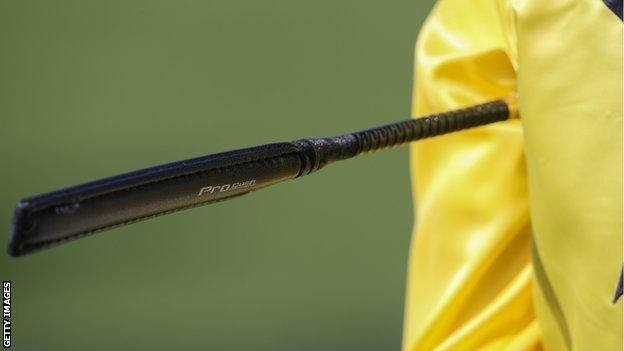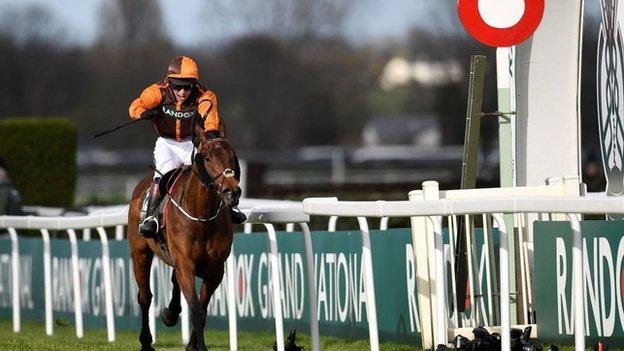
Horses whose jockeys seriously breach whip rules will be disqualified under new plans for British racing.
The rules will apply to riders who use four or more strikes above the permitted threshold.
Jockeys must use the whip in the backhand position only and face double the length of suspensions for overuse in major races.
The changes are put forward in a report by the British Horseracing Authority’s (BHA) whip consultation steering group.
If the rules had been in place earlier this year, Grand National winner Noble Yeats would have been disqualified.
Winning rider Sam Waley-Cohen was suspended for nine days and fined £400 for using his whip above the permitted level and in the incorrect place.
The amateur jockey did not serve the ban as he had already announced his retirement.
A minority of the steering group argued that the whip should be removed for encouragement, as is now the case in Scandinavia, but this was not adopted.
Any jump jockey who strikes their mount 12 times or more in a big race would have their horse disqualified under the new rules .
Flat riders would be penalised in the same way if they were to strike their mount 11 times, although both codes would allow leeway if a rider demonstrates a need to ensure their safety or that of fellow riders.
Jump jockeys are currently limited to eight strikes of the whip, with Flat jockeys restricted to seven.

What are the main recommendations?
It is intended the new rules will be implemented from late autumn, with a “bedding-in” period.
The report features 20 recommendations regarding rules, guidelines, penalties and procedures related to the use of the whip, including:
- Use of the ProCush whip should continue to be permitted for encouragement, but only in the backhand position
- Disqualification of the horse will be introduced where the whip is used four or more times above the permitted level
- Increased starting point for suspensions from two to three days, and greater fines for amateur riders
- Suspensions will be doubled for breaches in major races, including all Class 1 and Class 2 contests
- Proposed suspension for riders following a disqualification is 14 days in a standard race (up from seven) and 28 days in a major race (was nine)
- Greater focus on education and improving standards of use
- A whip review panel of stewards will be established, which will assess all potential offences
- Further objective research into the effects of the whip should be commissioned by the BHA, and efforts made to explain its design, use and regulation to key audiences
The recommendations were put forward following a review by a steering group, which included jockeys, trainers, owners, breeders and racecourses, along with World Horse Welfare.
More than 2,000 submissions were made by stakeholders and the public in an online questionnaire, with around two-thirds rejecting the idea of renaming the whip, although the vast majority of jockeys were in favour.
“It is inevitable that there will be those who think we have gone too far, and those who think we have not gone far enough,” said David Jones, chair of the steering group.
Jockeys are currently allowed to use the whip in both the forehand and backhand positions for encouragement, but it was felt restricting to backhand only would make the use of excessive force less likely.
“The change to using the whip only in the backhand will be a significant one for many riders, and the revised penalties are certainly strict,” said jockey Tom Scudamore, who was part of the steering group.
“However, I believe the increase in penalties will have the correct deterrent on those riding.”
How did we get here?
The whip rules were last reviewed 10 years ago when a maximum number of strikes – seven on the flat and eight over jumps – were introduced.
Racing’s leaders do not primarily believe use of a foam-padded whip is a welfare issue, but accept there is a negative perception among some sections of the wider public.
A BHA review in 2011 concluded that “the whip stimulates a horse and should not cause pain”, although the independently-chaired Horse Welfare Board (HWB) said three years ago that “scientific evidence relating to the welfare impacts of the whip remains inconclusive”.
Supporters of the whip believe it is a crucial tool for a rider, which helps with safety and is intrinsic to the business of thoroughbreds competing against each other.
Opponents insist that humans hitting animals is a bad look and whipping horses is a cruel act.
In December 2018 then BHA chief executive Nick Rust told the BBC that tougher penalties in big races were likely to be introduced.
Fifteen months later a consultation was planned – later postponed because of the pandemic – after the HWB said that, although the numbers of whip offences by riders were down, they remained “unpalatably high”.
